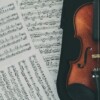
Making Nothing Happen: Five Poets Explore Faith and Spirituality
Reviewed by Mary M. Brown, English, Indiana Wesleyan University
All of the five contributors to Making Nothing Happen: Five Poets Explore Faith and Spirituality consider themselves both theologians and poets. Their formal educations and professions favor their positions in theology, but their practice confirms their place in the world of poetry. Gavin D’Costa, Eleanor Nesbitt, Mark Pryce, Ruth Shelton, and Nicola Slee are the Diviners, a British poetry-writing group that met regularly for twelve years before the publication of this book. The name of their group is well chosen, as the five of them share the “conviction that poetry itself may be a form of divination, a means of searching for the sacred, but also the means whereby we ourselves are searched out and our lives become the sacred ground in which the holy is discerned” (4).
The book promises to be of interest to all poets or theologians. As someone fully engaged in both poetry and theology, I tend to think the promise is kept. Most poets acknowledge the spirituality of their art, but a theologian who is not used to reading or writing poetry might have a harder time seeing the connection. Making Nothing Happen could make that first step in convincing those theologians that engagement with poetry could open up new dimensions in their thinking about God, spirituality, and faith.
Such conviction and a clear structure unify the book, which consists of an introduction and five chapters. Each chapter is authored by a different Diviner. Every Diviner begins with an essay on the ways that poetry and faith intersect the writer’s life and the world and ends with a small collection of the writer’s poems. Christians of various ilks, the authors bring their own aesthetics and theologies to the common question: does poetry have a “graced potential” (1) to illuminate the sacred? The five voices in the book all answer with a resounding yes, but each in a singular, insightful way.
The first chapter of the book—“(W)riting like a Woman: In Search of a Feminist Theological Poetics” by Nicola Slee—acknowledges Slee’s ongoing struggle to find a voice consistent with her identity as Anglican, poet, theologian, and woman, “to take up a subject position” (9) and help in the development of a feminine aesthetic. Slee begins by seeing that the connections between poetry and prayer “are more than the words themselves—they call us to something else, someone else perhaps, above and beyond the words” (11). She notes that both poetry and liturgy work subliminally, their power drawn from an unconscious source that involves the ear and heart, perhaps more than the mind. In that way, they also have a feminine quality. Slee presents the idea of a feminine savior, the “Christa,” a notion she explores in her poetry. In “At the Table of Christa” she writes,
The women do not serve
but are served
The children are not silent
but chatter
The menfolk do not dominate
but co-operate (40)
Slee’s Christa poems recognize the power of the feminine in approaching God. And all of her poetry—much of it not overtly spiritual—explores “faith’s extravagant languages of praise, blessing, lament and confession, all of which may be considered redundant, extraneous, ‘making nothing happen’ in the world” (27).
The second chapter of the book, Ruth Shelton’s “Steady until Sundown: Searching for the Holy,” suggests that spiritual seekers and poets inevitably have the same mission: “to foster a quality of attentiveness and an active readiness to see their location with new eyes and to encounter the divine in its places and people” (51). Shelton acknowledges that this is a dangerous enterprise, since we are prone to try to control the divine as soon as we recognize it, charge more for it, and so lift it out of the realm of the holy and into the world of the secular and mundane. A Roman Catholic, Shelton reminds us that Jesus did not separate secular and sacred; instead, “the words that he spoke and the manner of his death were all of a piece, like the seamless garment” (55). Interestingly, Shelton draws on the examples of artists like Allen Ginsburg and Pablo Picasso to illustrate how, in the words of William Blake, “Imagination is evidence of the Divine” (57).
Shelton’s poetry is a manifestation of this theology, of the connection between the holy and the ordinary, a theology that for me is best illustrated in these lines from Shelton’s poem “Remembering Earl”:
1 small cabbage, 1 lb pots, 1pkt.steaky (if cheap).
Rosary at 8. Write to Earl.
The butter sputters in my bent pan
Smearing Norah’s postcard of the Bridge of Sighs,
which I’d always imagined as puffs of breath,
like broken beads,
barely holding their own. (72)
Shelton practices what she preaches; she marries the mundane and the ethereal, the spiritual. She explains what she does in her poetry by saying “It is the nature of poetry to be dangerous, to burst through the cracks, to surprise, to invert, to praise, to illuminate: a list of activities which sounds very much like the job description of the Holy Spirit” (67).
Mark Pryce’s contribution to the collection is chapter 3, “Taking Form: On Becoming a Christian Poet,” a chapter that moves gracefully from Caedmon and his Hymn to his Pryce’s own “Lazarus Blossom”:
May this harvest be a regular blessing:
To pluck out of each fading
More than reprieve, more than salvage,
Even the gleanings of a resurrection.
Pryce rehearses the relationship between the communal nature of spirituality and the singularity of all theology and of faith itself.
He reinterprets the Parable of the Prodigal Son by envisioning the wealth of the family to be riches of the imagination. In the story the youngest son, an inheritor of the “poetic inheritance,” squanders his wealth in isolation, “the spending of artistic talent and skill without an appropriate sense of personal discipline” without giving tradition and community their proper due. Conversely, the older son who is angered by the feast offered in celebration of the return of his reckless brother, misunderstands the nature of his own poetic inheritance, the pleasures of company and grace, of blessings of generous abandon.
Pryce notes that the parable is a masculine tale that is preceded in the book of Luke by a more feminine one: the story of the woman who rejoices with her friends and neighbors when she finds a coin that has been lost. He notes that we must consider our spiritual and imaginative inheritance with appreciation as the woman considered her lost coin—in community, treating poetry, for instance, as “the continuing unfolding of the scriptures and companion to liturgy” (102).
“Where Poems Come From: Spirituality, Emotion and Poiesis” is Eleanor Nesbitt’s singular contribution to the larger work. A Quaker with an Anglican background, Nesbitt also has interest in the Sikh tradition and has married into a Hindu family. She discusses spirituality broadly, describing it as “a dimension that overlaps with human responses to beauty and with moral insights” (127). She states boldly that spirituality and poetry are linked, both of them prompted by emotion and in ways of “making the familiar strange as well as making the strange familiar” (131).
Nesbitt’s religious and cultural pluralism bring a new dimension to the book’s discussion of poetry and spirituality. Her poetry unpretentiously reflects that diversity as well as the holy silence that is assumed in her Quakerism. Nesbitt describes some of her poems as “bursting with questions” (141) and indeed they are, questions that leave room for answers from various perspectives, for no response at all (silence), for doubt and religious contemplation. Consider the first two stanzas of her poem “Theodicy”:
Cancer and evil…
Cancer and evolution…
Even cancer and even odds…
But cancer and God—or gods…?
God contemplating and creating cancer?
God remonstrating, God berating cancer?
Is God inclement, impotent
Or just inconsequential?
Or is my cancer somehow Providential? (149)
Gavin D’Costa’s “The Miracle of Poetry: Divine and Human Creativity,” the fifth and final chapter of the book, reminds readers of one way of understanding the word “miracle”: “seeing something familiar anew” (171). This kind of miracle is at the center of both poetry and spirituality, of metaphor and Eucharist. D’Costa states, “I do not want to secularise miracles nor divinize poetry. What I do want to do is stay with the boundary lines between these two zones, that become so porous, and in that process so interesting” (173). A Roman Catholic and an Indian, D’Costa, like Nesbitt, delights in his cultural fluidity, a source of both connection and loneliness that feeds D’Costa’s poetry and his spirituality. All of these things are illustrated by his poem:
Zen Buddhist Temple Visit
I did not see a Buddhist monk sit,
and breathe the subtle form
of trees, the patterned stones and
fashioned moss.
Instead, a Catholic priest, cracked by love
led me by the hand to see
a glimpse of his beloved Zen,
a space of grace, in between.
The Diviners, five diverse theologians and poets, have created a rich mosaic of faith, language, and insight in Making Nothing Happen: Five Poets Explore Faith and Spirituality. The title of the book, which alludes to W. H. Auden’s famous declaration that “poetry makes nothing happen” (as quoted in Making Nothing Happen, 1), belies the fact that the book’s essays and poetry motivate readers to make something happen—to read or even write poetry, to consider poetry as a strong—maybe even necessary—avenue toward real spiritual contemplation and development.























